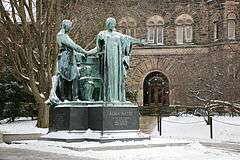Alma mater
Alma mater (Latin: alma "nourishing/kind", mater "mother"; pl. [rarely used] almae matres) is an allegorical Latin phrase for a university or college. It is used in American English to refer to a school which an individual has attended.[1] The phrase is variously translated as "nourishing mother", "nursing mother", or "fostering mother", suggesting that a school provides intellectual nourishment to its students.[2]
Before its modern usage, Alma mater was an honorific title in Latin for various mother goddesses, especially Ceres or Cybele,[3] and later in Catholicism for the Virgin Mary. The source of its current use is the motto Alma Mater Studiorum ("nurturing mother of studies") of the oldest university in the Western world in continuous operation: the University of Bologna, founded in 1088. It is related to the term alumnus, denoting a university graduate, and literally meaning a "nursling" or "one who is nourished".[4]
The phrase also refers to a song or hymn associated with a school.
Etymology
.jpg)
Although alma (nourishing) was a common epithet for Ceres, Cybele, Venus, and other mother goddesses, it was not frequently used in conjunction with mater in classical Latin.[5] In the Oxford Latin Dictionary, the phrase is attributed to Lucretius' De rerum natura, where it is used as an epithet to describe an earth goddess:
Denique caelesti sumus omnes semine oriundi |
We are all sprung from that celestial seed, |
After the fall of Rome, the term came into Christian liturgical usage in association with the Virgin Mary. "Alma Redemptoris Mater" is a well-known 11th century antiphon devoted to Mary.[5]
The earliest documented English use of the term to refer to a university is in 1600, when University of Cambridge printer John Legate began using an emblem for the university's press.[6][7] The device's first-known appearance is on the title-page of William Perkins' A Golden Chain, where the phrase Alma Mater Cantabrigia ("nourishing mother Cambridge") is inscribed on a pedestal bearing a nude, lactating woman wearing a mural crown.[8][9] In English etymological reference works, the first university-related usage is often cited in 1710, when an academic mother-figure is mentioned in a remembrance of Henry More by Richard Ward.[10][11]
Special usage
Many historic European universities have adopted Alma Mater as part of the Latin translation of their official name. The University of Bologna Latin name, Alma Mater Studiorum (nourishing mother of studies), refers to its status as the oldest continuously operating university in the world. Other European universities, such as the Alma Mater Lipsiensis in Leipzig, Germany, or Alma Mater Jagiellonica, Poland, have similarly used the expression in conjunction with geographical or foundational characteristics. At least one, the Alma Mater Europaea in Salzburg, Austria, an international university founded by the European Academy of Sciences and Arts in 2010, uses the term as its official name. The College of William & Mary in Williamsburg, Virginia, has been called the "Alma Mater of a Nation" because of its ties to the founding of the United States.[12] At Queen's University in Kingston, Ontario, and the University of British Columbia in Vancouver, British Columbia, the main student government is known as the Alma Mater Society.
Monuments

The ancient Roman world had many statues of the Alma Mater, some still extant (e.g. at the Palatine Hill in Rome).
Modern sculptures are found in prominent locations on several American university campuses. There is a well-known bronze statue of Alma Mater by Daniel Chester French situated on the steps of Columbia University's Low Library. The University of Illinois at Urbana–Champaign also has an Alma Mater statue by Lorado Taft. An altarpiece mural in Yale University's Sterling Memorial Library depicts the Alma Mater as a bearer of light and truth standing in the midst of the personified arts and sciences, painted in 1932 by Eugene Savage.
Outside the United States, there is an Alma Mater sculpture on the steps of the monumental entrance to the Universidad de La Habana, in Havana, Cuba. The statue was cast in 1919 by Mario Korbel, with Feliciana Villalón Wilson as the inspiration for Alma Mater. It was installed in its current location in 1927 at the direction of architect Raul Otero.[13]
References
- ↑ "Alma mater" at Dictionary.com. Retrieved July 11, 2011.
- ↑ Ayto, John (2005). Word Origins (2nd ed.). London: A&C Black. ISBN 9781408101605. Retrieved 18 May 2015.
- ↑ Shorter Oxford English Dictionary, 3rd edition
- ↑ Cresswell, Julia (2010). Oxford Dictionary of Word Origins. Oxford University Press. p. 12. Retrieved 18 May 2015.
- 1 2 Sollors, Werner (1986). Beyond Ethnicity: Consent and Descent in American Culture. Oxford University Press. p. 78. ISBN 9780198020721.
- ↑ Stokes, Henry Paine (1919). Cambridge stationers, printers, bookbinders, &c. Cambridge: Bowes & Bowes. p. 12. Retrieved 18 May 2015.
- ↑ Roberts, S. C. (1921). A History of the Cambridge University Press 1521-1921. Cambridge: Cambridge University Press. Retrieved 18 May 2015.
- ↑ Stubbings, Frank H. (1995). Bedders, Bulldogs and Bedells: A Cambridge Glossary (2nd ed.). p. 39.
- ↑ Perkins, William (1600). A Golden Chaine: Or, the Description of Theologie, containing the order and causes of salvation and damnation, according to God's word. Cambridge: University of Cambridge. Retrieved 18 May 2015.
- ↑ Harper, Douglas. "Alma mater". Online Etymological Dictionary. Retrieved 18 May 2015.
- ↑ Ward, Richard (1710). The Life of the Learned and Pious Dr. Henry More, Late Fellow of Christ's College in Cambridge. London: Joseph Downing. p. 148. Retrieved 18 May 2015.
- ↑ "William & Mary – History & Traditions". wm.edu.
- ↑ Cremata Ferrán, Mario. "Dos rostros, dos estatuas habaneras". Opus Habana. Retrieved 21 January 2015.
External links
 Media related to Alma mater at Wikimedia Commons
Media related to Alma mater at Wikimedia Commons The dictionary definition of alma mater at Wiktionary
The dictionary definition of alma mater at Wiktionary- Alma Mater Europaea website